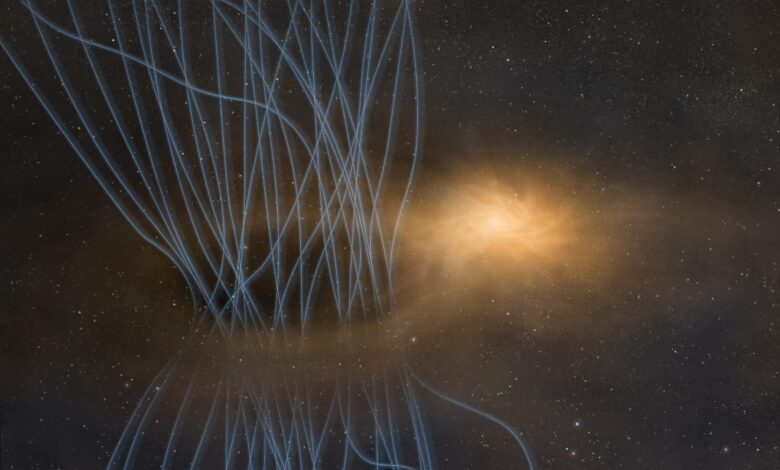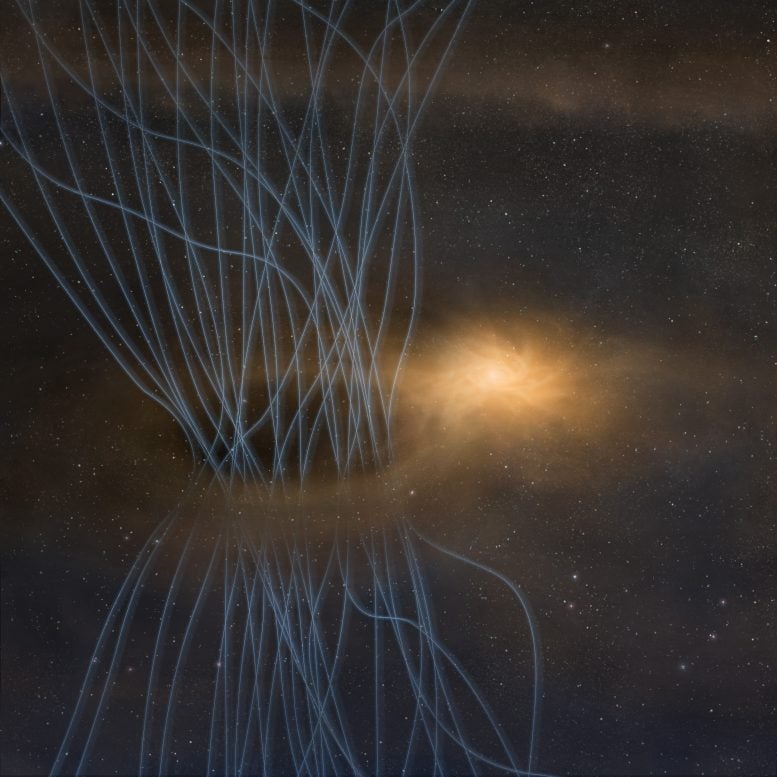“Quite Unexpected” – Astronomers Discover Strange Spike-Like Structures Extending From Protostellar Disk


The baby star at the center surrounded by a bright disk called a protostellar disk. Spikes of magnetic flux, gas, and dust in blue. Researchers found that the protostellar disk will expel magnetic flux, gas, and dust—much like a sneeze—during a star’s formation. Credit: ALMA (ESO/NAOJ/NRAO)
Researchers have discovered that baby stars emit plumes of magnetic flux during their formation.
Researchers from Kyushu University have unveiled new insights into the development of baby stars. Utilizing the ALMA radio telescope in Chile, the team discovered that the protostellar disk surrounding a nascent star expels plumes of dust, gas, and electromagnetic energy in its early stages. These ejections, referred to as ‘sneezes’ by the researchers, release the magnetic flux within the protostellar disk and may play a crucial role in star formation. Their findings have been published in The Astrophysical Journal.
Stars, including our Sun, all develop from what are called stellar nurseries, large concentrations of gas and dust that eventually condense to form a stellar core, a baby star. During this process, gas and dust form a ring around the baby star called the protostellar disk.
“These structures are perpetually penetrated by magnetic fields, which brings with it magnetic flux. However, if all this magnetic flux were retained as the star developed, it would generate magnetic fields many orders of magnitude stronger than those observed in any known protostar,” explains Kazuki Tokuda of Kyushu University’s Faculty of Sciences and first author of the study.
For this reason, researchers have hypothesized that there is a mechanism during star development that would remove that magnetic flux. The prevailing view was that the magnetic field gradually weakened over time as the cloud was pulled into the stellar core.
Mechanisms of Magnetic Flux Expulsion
To get to the bottom of this mysterious phenomenon, the team set their sights on MC 27, a stellar nursery located approximately 450 light-years from Earth. Observations were collected using the ALMA array, a collection of 66 high-precision radio telescopes constructed 5,000 meters above sea level in northern Chile.
“As we analyzed our data, we found something quite unexpected. There were these ‘spike-like’ structures extending a few astronomical units from the protostellar disk. As we dug in deeper, we found that these were spikes of expelled magnetic flux, dust, and gas,” continues Tokuda.
“This is a phenomenon called ‘interchange instability’ where instabilities in the magnetic field react with the different densities of the gases in the protostellar disk, resulting in an outward expelling of magnetic flux. We dubbed this a baby star’s ‘sneeze’ as it reminded us of when we expel dust and air at high speeds.”
Additionally, other spikes were observed several thousands of astronomical units away from the protostellar disk. The team hypothesized that these were indications of other ‘sneezes’ in the past.
The team expects their findings will improve our understanding of the intricate processes that shape the universe that continue to captivate the interest of both the astronomical community and the public.
“Similar spike-like structures have been observed in other young stars, and it’s becoming a more common astronomical discovery,” concludes Tokuda. “By investigating the conditions that lead to these ‘sneezes’ we hope to expand our understanding of how stars and planets are formed.”
Reference: “Discovery of Asymmetric Spike-like Structures of the 10 au Disk around the Very Low-luminosity Protostar Embedded in the Taurus Dense Core MC 27/L1521F with ALMA” by Kazuki Tokuda, Naoto Harada, Mitsuki Omura, Tomoaki Matsumoto, Toshikazu Onishi, Kazuya Saigo, Ayumu Shoshi, Shingo Nozaki, Kengo Tachihara, Naofumi Fukaya, Yasuo Fukui, Shu-ichiro Inutsuka and Masahiro N. Machida, 11 April 2024, The Astrophysical Journal.
DOI: 10.3847/1538-4357/ad2f9a
The study was funded by the National Astronomical Observatory of Japan and the Japan Society for the Promotion of Science.



